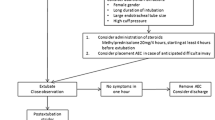Abstract
A 50-year-old woman underwent laryngoscopy. Postoperatively she received naloxone and was extubated. She developed severe laryngospasm and one hour later pulmonary edema. Both naloxone administration and laryngospasm can provoke pulmonary edema; the pathophysiology is discussed. It is suggested that naloxone is administered with care to patients who in the preceding hours have had severe laryngospasm.
Similar content being viewed by others
References
Flacke JW, Flacke WE, Williams GD (1977) Acute pulmonary edema following naloxone reversal of high-dose morphine anesthesia. Anesthesiology 47:376–378
Prough DS, Roy R, Bumgarner J, Shannong G (1984) Acute pulmonary edema in healthy teenagers following conservative doses of intravenous naloxone. Anesthesiology 60:485–486
Lee KW, Downes JJ (1983) Pulmonary edema secondary to laryngospasm in cluldren. Anesthesiology 59:347–349
Weissman C, Damask MC, Yang J (1984) Noncardiogenic pulmonary edema following laryngeal obstruction. Anesthesiology 60:163–165
Stalcup SA, Mellins RB (1977) Mechanical forces producing pulmonary edema in acute asthma. N Eng J Med 297:592–596
Pavlin DJ, Nessly ML, Cheney FW (1981) Increased pulmonary vascular permeability as a cause of reexpansion edema in rabbits. Am Rev Respir Dis 124:422–427
Marland AM, Glauser FL (1982) Hemodynamic and pulmonary edema protein measurement in a case of reexpansion pulmonary edema. Chest 81:250–251
Drinker CK (1945) Pulmonary edema and inflammation. Analysis of processes involved in formation and removal of pulmonary transudates and exudates. Harvard University Press, Cambridge, Massachusetts, pp 24–44
Moss G, Staunton C, Stein AA (1973) The centrineurogenic etiology of the acute respiratory distress syndromes. Am J Surg 126:37–41
Bowers RE, McKeen CR, Park BE, Brigham KL (1979) Increased pulmonary vascular permeability follows intracranial hypertension in sheep. Am Rev Resp Dis 119:637–641
Sarnof SJ, Berglund E, Sarnoff LC (1953) Neurohemodynamics of pulmonary edema. J Appl Physiol 5:367–374
Andree RA (1980) Sudden death following naloxone administration. Anesth Analg 59:782–784
Azar I, Turndorf H (1979) Severe hypertension and multiple atrial premature contractions following naloxone administration. Anesth Analg 58:524–525
Author information
Authors and Affiliations
Rights and permissions
About this article
Cite this article
Olsen, K.S. Naloxone administration and laryngospasm followed by pulmonary edema. Intensive Care Med 16, 340–341 (1990). https://doi.org/10.1007/BF01706365
Received:
Accepted:
Issue Date:
DOI: https://doi.org/10.1007/BF01706365



